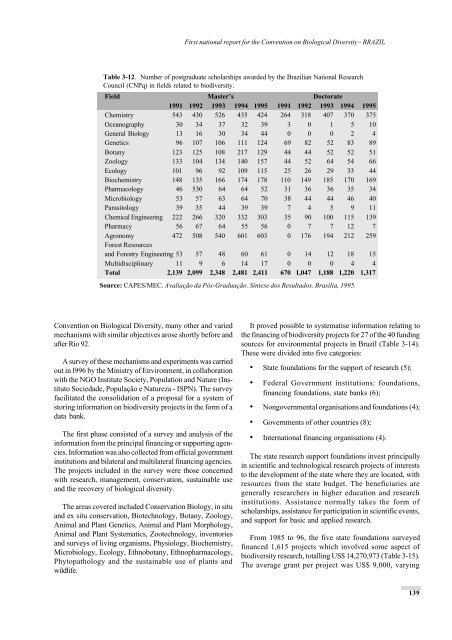Brazil (Part VIII, English version) - Convention on Biological Diversity
Brazil (Part VIII, English version) - Convention on Biological Diversity
Brazil (Part VIII, English version) - Convention on Biological Diversity
- No tags were found...
Create successful ePaper yourself
Turn your PDF publications into a flip-book with our unique Google optimized e-Paper software.
First nati<strong>on</strong>al report for the <str<strong>on</strong>g>C<strong>on</strong>venti<strong>on</strong></str<strong>on</strong>g> <strong>on</strong> <strong>Biological</strong> <strong>Diversity</strong> - BRAZILTable 3-12. Number of postgraduate scholarships awarded by the <str<strong>on</strong>g>Brazil</str<strong>on</strong>g>ian Nati<strong>on</strong>al ResearchCouncil (CNPq) in fields related to biodiversity.Field Master’s Doctorate1991 1992 1993 1994 1995 1991 1992 1993 1994 1995Chemistry 543 430 526 435 424 264 318 407 370 375Oceanography 30 34 37 32 39 3 0 1 5 10General Biology 13 16 30 34 44 0 0 0 2 4Genetics 96 107 106 111 124 69 82 52 83 89Botany 123 125 108 217 129 44 44 52 52 51Zoology 133 104 134 140 157 44 52 64 54 66Ecology 101 96 92 109 115 25 26 29 33 44Biochemistry 148 135 166 174 178 110 149 185 170 169Pharmacology 46 530 64 64 52 31 36 36 35 34Microbiology 53 57 63 64 70 38 44 44 46 40Parasitology 39 35 44 39 39 7 4 5 9 11Chemical Engineering 222 266 320 332 303 35 90 100 115 139Pharmacy 56 67 64 55 56 0 7 7 12 7Agr<strong>on</strong>omy 472 508 540 601 603 0 176 194 212 259Forest Resourcesand Forestry Engineering 53 57 48 60 61 0 14 12 18 15Multidisciplinary 11 9 6 14 17 0 0 0 4 4Total 2,139 2,099 2,348 2,481 2,411 670 1,047 1,188 1,220 1,317Source: CAPES/MEC. Avaliação da Pós-Graduação. Síntese dos Resultados. Brasília, 1995.<str<strong>on</strong>g>C<strong>on</strong>venti<strong>on</strong></str<strong>on</strong>g> <strong>on</strong> <strong>Biological</strong> <strong>Diversity</strong>, many other and variedmechanisms with similar objectives arose shortly before andafter Rio 92.A survey of these mechanisms and experiments was carriedout in l996 by the Ministry of Envir<strong>on</strong>ment, in collaborati<strong>on</strong>with the NGO Institute Society, Populati<strong>on</strong> and Nature (InstitutoSociedade, População e Natureza - ISPN). The surveyfacilitated the c<strong>on</strong>solidati<strong>on</strong> of a proposal for a system ofstoring informati<strong>on</strong> <strong>on</strong> biodiversity projects in the form of adata bank.The first phase c<strong>on</strong>sisted of a survey and analysis of theinformati<strong>on</strong> from the principal financing or supporting agencies.Informati<strong>on</strong> was also collected from official governmentinstituti<strong>on</strong>s and bilateral and multilateral financing agencies.The projects included in the survey were those c<strong>on</strong>cernedwith research, management, c<strong>on</strong>servati<strong>on</strong>, sustainable useand the recovery of biological diversity.The areas covered included C<strong>on</strong>servati<strong>on</strong> Biology, in situand ex situ c<strong>on</strong>servati<strong>on</strong>, Biotechnology, Botany, Zoology,Animal and Plant Genetics, Animal and Plant Morphology,Animal and Plant Systematics, Zootechnology, inventoriesand surveys of living organisms, Physiology, Biochemistry,Microbiology, Ecology, Ethnobotany, Ethnopharmacology,Phytopathology and the sustainable use of plants andwildlife.It proved possible to systematise informati<strong>on</strong> relating tothe financing of biodiversity projects for 27 of the 40 fundingsources for envir<strong>on</strong>mental projects in <str<strong>on</strong>g>Brazil</str<strong>on</strong>g> (Table 3-14).These were divided into five categories:• State foundati<strong>on</strong>s for the support of research (5);• Federal Government instituti<strong>on</strong>s: foundati<strong>on</strong>s,financing foundati<strong>on</strong>s, state banks (6);• N<strong>on</strong>governmental organisati<strong>on</strong>s and foundati<strong>on</strong>s (4);• Governments of other countries (8);• Internati<strong>on</strong>al financing organisati<strong>on</strong>s (4).The state research support foundati<strong>on</strong>s invest principallyin scientific and technological research projects of intereststo the development of the state where they are located, withresources from the state budget. The beneficiaries aregenerally researchers in higher educati<strong>on</strong> and researchinstituti<strong>on</strong>s. Assistance normally takes the form ofscholarships, assistance for participati<strong>on</strong> in scientific events,and support for basic and applied research.From 1985 to 96, the five state foundati<strong>on</strong>s surveyedfinanced 1,615 projects which involved some aspect ofbiodiversity research, totalling US$ 14,270,973 (Table 3-15).The average grant per project was US$ 9,000, varying139
















